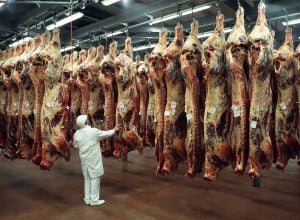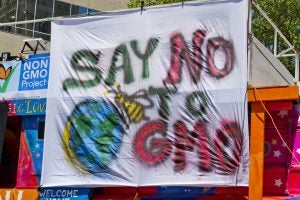In a twist of remarkable irony, the very agencies that were put in place to protect each nation’s food supply, health, and environment are now often viewed with suspicion. This follows an overall trend in where, in general, trust in the expertise of society’s authorities appears to be at an all-time low.
What psychology repeatedly tests as the most fearful, anxious, and worried generations in history did not happen by accident. World War II had developed in the previous generations a genuine sense that citizens were united in making society happen. The natural deterioration of that sense happened over time, to everyone except farmers. They still needed their neighbors.
By the 1980s, cities were getting so disconnected that impressionable parents were teaching their children the concept of stranger danger. Considering the fact that modern parents were taught as children that strangers were potentially lethal, today’s lack of trust makes more sense.
Society has now realized that was an enormous overreaction to news events, and it has had impacts on society. But throughout history there has been and will always be a most-scared person available to promote a more fearful society, and clearly the fear-producing crowd has been quite successful. But we can’t have a world of all parachutes. We need airplanes, too.
During the same time period that stranger danger was happening, many politicians started marketing the idea of government as “the problem.” Even though farmers are very independently minded and are, understandably, not keen on too much government, we all still must accept that actual anti-government sentiments did open up the idea for the public that, if they couldn’t trust the government, then by proxy they also couldn’t trust their regulators.
Another huge contributor was that the ’80s and ’90s were when 24-hour we-need-to-fill-it cable news was taking shape all while fear campaigns were ramping up as a primary mode of marketing and advertising, particularly when it came to food or drugs. While fear is a marketer’s dream tool, in society its use is corrosive, and it undermines the role of public regulators.
When making health decisions the public needed facts, not intentionally misleading sales pitches. But any concerns about misleading traditional advertising seemed minor once the internet and social media struck.
Unchecked, unvalidated false expertise has at least temporarily devalued real education and expertise almost entirely. At the same time, it has amplified baseless fears and has, in large part, created the “clean-eating” movement that has led to an epidemic of eating disorders.
We’ve all seen them. Examples include potentially dangerous “natural” supplements, which base their sales on the public being taught not to trust the FDA. When it comes to food, marketers want to sell the cheaper food as being potentially more dangerous, but every time they make that false assertion they are simultaneously suggesting that the USDA regulators did not do their job. Far too many parents have lost children due to a lack of trust in “Western medicine.”
Everyone in agriculture must remember that the regulating is invisible to the public, but the marketing and influencers are on every screen they look at. If people don’t trust the medical system and drug trials, then their false view of the drug system will be directly translated to their sense of the safety of the food system simply, due to both being administered all or in part by the FDA.
To the public it appears that some brands are protecting them from the regulators when, in many cases, they’re putting them at greater risk.
The evidence of these effects are everywhere, from food sales, to supplement sales, to Goop, to lower rates of vaccination. The suspicious ideas that lead to these examples are obviously personally insulting to the character of millions of the fellow citizens who are our farmers and scientists and doctors. Despite that, these concerns must be addressed fairly because they are sincerely held.
Whether the fear is about a drug, an apple, or a river, in principle the problem is that people don’t trust the agricultural industry nor its regulators. Our goal should be to sincerely resolve that lack of trust.
At the table
Food and agriculture companies are the groups many people feel shouldn’t be at the table when it comes to food regulation. But this is where people in-the-know need to kindly point out that there is no point in growing safe, healthy food if it can’t be produced, harvested, shipped, processed, and delivered in a manner that is scientifically and logistically possible, and at a price that people can afford.
Science, logistics, and inspection are very real and necessary parts of a food system, but people’s lack of consideration of those aspects is innocent. That is something we can correct. It should also be noted to concerned eaters that the supposedly colluding players’ needs often actually function at odds.
No regulator wants their family eating dangerous food or their environment destroyed; no farmer wants to buy more chemical than they really need to, or adhere to rules that don’t make economic or scientific sense; and no company likes having its products taken off the market — but regulators do it. Our protection exists in the natural tension between the differing needs of the farmers, the companies, and we the eaters.
Society’s focus on these subjects is not new. The U.S. government first began testing agricultural chemicals for safety as early as 1848, and it had formed an official regulatory framework by 1906. The modern Food and Drug Administration (the FDA) was formed in 1930 as a single organization that combined the various resources focused on citizen safety. Most modern nations had counterparts around the same time or earlier.

It also didn’t take long for the North American public and their governments to recognize that many of the issues with food safety and security could be resolved by changes to agriculture. It is important to note that finding and implementing those changes was seen as a cooperative effort between farmers, government, and the public. So much so that when Abraham Lincoln signed the United States Department of Agriculture (the USDA) into being in 1862, he later described it as “The People’s Department.”
Likewise, Canada saw the formation of what was then called Agriculture and Agri-Food Canada in 1868, only one year after the nation seceded from British rule. Food security and its safety have always been important subjects for any nation’s national security.
Today, many members of the Greatest and Silent Generations are still alive. During their lifetimes the average lifespan in North America has gone from 47.3 to almost 79. Michelangelo lived in the 1500s and died at age 88, so people shouldn’t mistake history’s short lifespans for short lives. Many people got very old. But prior to the Green and medical revolutions, so many people died before 5 years of age that it brought the average down to below 50.
The success of organizations like the USDA and the FDA are largely why lifespans have increased by over 50 percent in a very short time. That’s something for humans to be proud of, and hardly the grounds for suspicion.
When it comes to the environment, the EPA was a national demand following a public furor. Marine Biologist Rachel Carson’s 1962 book “Silent Spring” had largely formed the environmental movement by exposing the unintentional misuse of industrial chemicals, but that abstract threat was made real for society after high pollution levels led the Cuyahoga River to catch fire in 1969. The response were shifts in thinking regarding chemistry at the USDA and FDA, and ultimately the formation of the EPA by Richard Nixon in 1970. All new industrial chemicals have been analyzed and monitored since then.
As more became known, farmers had legitimate concerns about their families being as safe as possible. That, combined with a fear of new rules from the new environmental agency prompted chemical companies to invest even more heavily into research on safer chemicals.
That boost of interest did help, but in fairness chemical companies were already searching for better chemicals due to the competitive market situation they are in. If your chemical does the same thing as your competitor but keeps the farmer and their family safer, you win the sale.
Ironically, this effort lead to the creation of legitimately brilliant inventions like glyphosate, and all farmers and relevant scientists know glyphosate is no conspiracy. It’s popular for the most logical reason of all: It is effective and safe for both people and the environment.
Unfortunately, Carson’s very valid book got intertwined by chance with a rash of newsworthy events and major films about corporate malfeasance and other mythical and self-aggrandizing stories by people like Erin Brockovich. These often sold a lot of books or advertising, and they created a lot of public hype, but they also often lacked a lot of facts. It’s left a sad result.
Rather than realizing that the EPA was created by (and the USDA and FDA changed by) forces like, “Silent Spring,” the public in much of the modern G20 world still largely believes that agriculture has never left the 1960s. In reality it’s changed as much as computers have in 60 years.
Meanwhile, quietly and boringly in the background, through all of this, the science geek regulators were using the facts to help guide the public to the most sensible solutions evidence could prove existed.
A success story goes wrong
While the 100 years prior to 1970s saw public science increasingly used to keep citizens in developed nations safe, the 1980s saw a president declare that “… government isn’t the solution to our problem, government is the problem.”
That sentiment was popular far and wide. But even if we sincerely feel that government is intrusive and should be minimized — and many farmers everywhere do — we still must also remember that in any democratic nation the concept of government is constructed from another famous Lincolnism; “… of the people, by the people, for the people”
In practice the government is us. It is our friends, our neighbors and school friends. Regulators are our roommates from college or the coach of our child’s sports team or the guy at the gym. They are the spouses of our music teacher, or the parents of our dearest friends. They might even be in our family.
To suggest that a public agency is working against the public is to forget that the people in the public agency are also a part of the pubic. They breathe the same air, shop in the same stores, give their kids the same vaccines, and they eat the same foods. The idea that they would conspire to hurt their own loved ones simply makes no sense.

Despite all of that, as the glyphosate story shows us, the genius of an extremely valuable tool can threaten to be irrelevant if the public believes an ad campaign by a company using chemophobia to market “naturalness.”
The problem has historically been that the argument in favor of smart science happens between scientists and farmers. That is a B-to-B, business-to-business conversation, and certain expertise is presumed.
In contrast, the discussion for food marketers is between marketers and the public. They are in B-to-C communications, where they are attempting to influence the behavior of consumers who are often operating with misconceptions. The additional problem with that is, fear is well known as a major motivator in purchases and, as previously noted, today’s modern population was well-prepared to be anxious, worried, afraid, or distrusting.
A society reacts
Parents raised not to trust their fellow citizens, large self-interested corporations creating myths to help market their foods, an invisible regulatory system; is it any wonder we find ourselves engaged with genuine conspiracy theorists in largely irrational, discussions around food and agriculture?
Neither the government nor industry can really blame consumers. Some companies are to the point where they even help form or fund shadow nonprofits to help facilitate their fear-based influences. The Non-GMO Project and the Environmental Working Project are two examples of partisan groups that many people in science and agriculture feel have done far more to sell products and increase eating disorders than they have to keep any consumer safer.
But these are all subtle forces that each push in roughly the same direction. And it adds up. The fact is, the public is operating with a mass misconception that their food is unsafe when in reality we have never had fewer issues, found them faster, or with more precise tools.
The erosion of trust in most agencies happened over time, issue by issue, advertisement by advertisement. But it does not need to be rebuilt over time. These misconceptions can be popped more like bubbles because there is no problem to solve.
It’s not that food and farming are not regulated. It’s that we have not been effective enough at explaining to the public more about the structures and systems that exist between farmer’s farms and eater’s plates. Everything agriculture does, it does for a reason. We need to do a better job of explaining those reasons.
The advantage for farmers and regulators and scientists is that the public’s beliefs are so often so outrageous that it becomes much easier to dispel them. Most hinge on extremely flimsy myths or illogical ideas, and many people simply don’t realize that foods and farms have been successfully regulated for well over 100 years.
Despite it sometimes being touted as so, the fact that the FDA does recalls is not a sign of failure, it is a sign of success. It is evidence that the regulator is working to keep citizens safe. And that matters. Because it’s those kinds of little success stories that agriculture could be better at sharing. Many drops fill a bucket.
In the end, neither farmers nor government regulators are alien to us. They are our friends, our neighbors, the spouses of our children’s teachers, or the parents of a co-worker. They are the fourth generation farm kid working in town, the geeky kids in high school who went into the sciences, or a grandson who took up biology after the suicide of a grandfather following a series of rough harvests.
There is cancer in their families, and clean eating disorders too. They also care about their rivers and trees and wildlife and children — in many cases it was seeing the value of those things that lead people into science in the first place. Regulators are doing a job, but they buy the same foods, from the same companies, in the same stores as all of the rest of us. “… of the people, by the people, for the people.”
Putting any genuinely paranoid delusions of a massive food conspiracy aside, is there any better guarantee of healthy food and a sustainable environment than the fact that the people who grow it, process it, sell it, and inspect it, also live and eat alongside all of us?
Far from worrying about our food, we should marvel at how no previous generations in history have enjoyed foods as healthy and sustainable and secure as those we enjoy today.
That being the case, it might be best for a society bombarded with stress hormones to consider trading its fears for gratitude and optimism and all of the very real benefits that go with them. After all, half a lifetime is no small thing for farmers and regulators to have given us.



